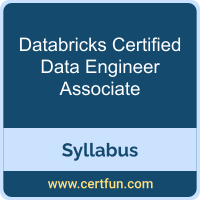 Use this quick start guide to collect all the information about Databricks Data Engineer Associate Certification exam. This study guide provides a list of objectives and resources that will help you prepare for items on the Databricks Certified Data Engineer Associate exam. The Sample Questions will help you identify the type and difficulty level of the questions and the Practice Exams will make you familiar with the format and environment of an exam. You should refer this guide carefully before attempting your actual Databricks Certified Data Engineer Associate certification exam.
Use this quick start guide to collect all the information about Databricks Data Engineer Associate Certification exam. This study guide provides a list of objectives and resources that will help you prepare for items on the Databricks Certified Data Engineer Associate exam. The Sample Questions will help you identify the type and difficulty level of the questions and the Practice Exams will make you familiar with the format and environment of an exam. You should refer this guide carefully before attempting your actual Databricks Certified Data Engineer Associate certification exam.
The Databricks Data Engineer Associate certification is mainly targeted to those candidates who want to build their career in Data Engineer domain. The Databricks Certified Data Engineer Associate exam verifies that the candidate possesses the fundamental knowledge and proven skills in the area of Databricks Lakehouse Data Engineer Associate.
Databricks Data Engineer Associate Exam Summary:
| Exam Name | Databricks Certified Data Engineer Associate |
| Exam Code | Data Engineer Associate |
| Exam Price | $200 (USD) |
| Duration | 90 mins |
| Number of Questions | 45 |
| Passing Score | 70% |
| Books / Training | Data Engineering with Databricks |
| Schedule Exam | Databricks Webassesor |
| Sample Questions | Databricks Data Engineer Associate Sample Questions |
| Practice Exam | Databricks Data Engineer Associate Certification Practice Exam |
Databricks Lakehouse Data Engineer Associate Exam Syllabus Topics:
| Topic | Details | Weights |
|---|---|---|
| Databricks Intelligence Platform |
- Enable features that simplify data layout decisions and optimize query performance. - Explain the value of the Data Intelligence Platform. - Identify the applicable compute to use for a specific use case. |
10% |
| Development and Ingestion |
- Use Databricks Connect in a data engineering workflow. - Determine the capabilities of Notebooks functionality. - Classify valid Auto Loader sources and use cases. - Demonstrate knowledge of Auto Loader syntax. - Use Databricks' built-in debugging tools to troubleshoot a given issue. |
30% |
| Data Processing & Transformations |
- Describe the three layers of the Medallion Architecture and explain the purpose of each layer in a data processing pipeline. - Classify the type of cluster and configuration for optimal performance based on the scenario in which the cluster is used. - Emphasize the advantages of LDP (for ETL process in Databricks). - Implement data pipelines using LDP. - Identify DDL (Data Definition Language)/DML features. - Compute complex aggregations and Metrics with PySpark Dataframes. |
31% |
| Productionizing Data Pipelines |
- Identify the difference between DAB and traditional deployment methods. - Identify the structure of Asset Bundles. - Deploy a workflow, repair, and rerun a task in case of failure. - Use serverless for a hands-off, auto-optimized compute managed by Databricks. - Analyzing the Spark UI to optimize the query. |
18% |
| Data Governance & Quality |
- Explain the difference between managed and external tables. - Identify the grant of permissions to users and groups within UC. - Identify key roles in UC. - Identify how audit logs are stored. - Use lineage features in Unity Catalog. - Use the Delta Sharing feature available with Unity Catalog to share data. - Identify the advantages and limitations of Delta sharing. - Identify types of delta sharing- Databricks vs external system. - Analyze the cost considerations of data sharing across clouds. - Identify Use cases of Lakehouse Federation when connected to external sources. |
11% |
To ensure success in Databricks Lakehouse Data Engineer Associate certification exam, we recommend authorized training course, practice test and hands-on experience to prepare for Databricks Certified Data Engineer Associate exam.
